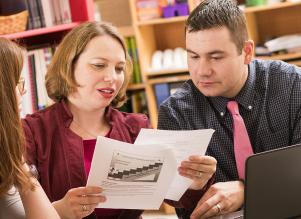11/20/2017
Measuring School Success Beyond Test Scores
A decade and a half after the No Child Left Behind Act was passed by the federal government, standardized test scores continue to be the most common measure of success and failure for public schools across the United States. To answer the question “How are our schools doing?” everyone from policymakers and administrators to parents and the general public is used to turning to one thing: test scores. A good school has high test scores, right? Not necessarily.
In recent years, renewed concepts such as “growth”—which looks at how much individual students improve over the course of a year—have complicated test scores. Fifteen years after the start of No Child Left Behind, studies show test scores are impacted by numerous societal factors that affect children's lives (such as family income, race, culture, and quality of preschool), raising concerns about how much stock should be put into the results of the high-stakes standardized tests used by public schools in the post-No Child Left Behind era.
All of which begs the question: How do we measure success in schools without using test scores? This is not to say testing has no place in diagnosing problem areas or offering a snapshot of student learning. However, as the federal government moves to embrace a renewed education platform through the Every Student Succeeds Act (ESSA), it seems justified to take a closer look at what success beyond test scores might mean. Fortunately, there are many good examples to consider.
For instance, in 2012, the Washington D.C. Public Charter School Board put a more comprehensive school quality plan into place. Over 40,000 students attend charter schools in the nation’s capital, a majority of whom come from racial minority and/or economically disadvantaged communities. The 2012 plan sought to move beyond narrow test score measurements by tapping into a range of quality indicators to evaluate and rank how schools were doing. These alternate measures—which are still in use today in 2017—include parent satisfaction, attendance, and graduation rates, according to D.C. Public Charter School Board Director Scott Peterson.
This more comprehensive approach to measuring school quality has been catalogued on the D.C. Public Charter School Board’s website, where parents and other interested parties can find School Quality Reports for every D.C. charter school; one click on a school’s name pulls up a colorful, detailed look at how the school measures up. The most recent available reports are from 2016 and cover a range of school achievement categories, including Student Progress (measuring academic improvement over time); Student Achievement (documenting student performance on math and reading tests); and School Environment (looking at a school’s attendance rate and the “percent of students eligible to re-enroll”). The D.C. Public Charter School Board also offers parent guides in a variety of languages, as well as further reports on every charter school’s attendance, discipline, and truancy data.
The social-emotional skills survey is another option for measuring school quality beyond academics. In a 2015 piece called “What Schools Could Use Instead of Standardized Tests,” National Public Radio reporter Anya Kamenetz found that Maryland’s Montgomery County school district uses a 20-question survey to gauge students’ “levels of hope, engagement, and wellbeing” at school. Kamenetz reported that students’ level of hope was found to offer a better prediction of future success than many other traditional, test-based measures.
Some schools have a history of using performance-based assessments such as portfolios of student work to show what students are learning and how they are progressing. Of course, these are not as easy to quantify on a graph or in a newspaper article, but according to the education group ASCD, allowing students to demonstrate what they’ve learned is an essential testing companion—not a competitor: “Traditional testing helps answer the question, ‘Do you know it?’ and performance assessment helps answer the question, ‘How well can you use what you know?’”
With the end of No Child Left Behind, schools are able to move toward a greater understanding of what success in the nation’s public schools looks like from many different vantage points.


